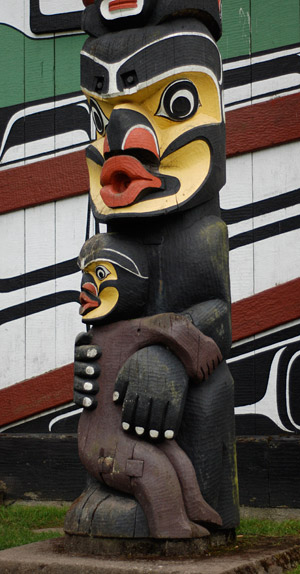
How did the traditional character of the cannibal ogress Dzunuk’wa come to be claimed by cryptozoologists as a depiction of their hypothesized “Bigfoot” cryptid species? (Kwakwaka’wakw heraldic pole. Carved in 1953 by Mungo Martin, David Martin, and Mildred Hunt. Thunderbird Park at the Royal British Columbia Museum, Victoria. Photograph by Daniel Loxton)
My research has often led me to consider how folkloric phenomena are brought under the umbrella of cryptozoology (the largely pseudoscientific “study” of legendary, allegedly “hidden” animals). In this active process, fuzzy abstractions—fluid supernatural conceptions, diverse “saw something weird” events, stories, metaphors, and shifting myths—are distilled down into more-or-less concrete hypothetical “species” of cryptids. For want of a better term, I’ve started to think of this cultural crystallization process as “cryptozoologification.”1 And it’s a bit of a problem. When the mists of folklore are reified as the discrete objects of cryptozoological pursuit, something is not only lost, but actively discarded.
I’m by no means the first to raise that conceptual concern (and it’s the concept I really wish to promote here, not the imperfect neologism). Sharon Hill has recently taken up the topic (here and here), calling this “the illusion of facticity.” Hill riffs on Lake Monster Traditions: a Cross-Cultural Analysis, by Michel Meurger with Claude Gagnon (London: Fortean Times, 1988), which gives a great deal of critical attention to this “scientification of folklore.” (This is surely one of the most important cryptozoology books ever written—a road map for a type of folklorically-aware skeptical approach I’ve sometimes called “post-cryptid cryptozoology.”)
In recent years, the point has perhaps been best made by Charles Paxton‘s excellent 2010 Fortean Times article “The Monster Manual,” which argued that the impulse to neatly classify monsters has the effect of misrepresenting both folklore and eyewitness testimony. “Classifying monsters seems a natural way to consider reports of unknown animals,” Paxton granted, and consequently “there are numerous encyclopædias and compilations of monsters available—essentially, versions of the [Dungeons & Dragons] Monster Manual with collections of creatures from folklore, myth and legend.” But categorization may draw intuitively “natural” lines where they do not belong, projecting artificial grids onto swirling ephemeral clouds. Paxton continues,
Classifying monsters like this is of interest to the casual reader and perhaps provides a framework to consider cryptozoological reports, but the trouble is, such subjective shoehorning doesn’t work. It’s misleading and can lead to invalid conclusions. Real monsters—by which I mean, paradoxically, the monsters of folklore, myth, legend and, indeed, eyewitness reports—are not Dungeons and Dragons monsters. They are not easily classified. They are conceptually amorphous and difficult to define. Fireside tales are not associated with morphological or zoological precision. Names and characteristics of monsters do not conform to the rigid minds of modern-day cryptozoologists. Snarks overlap with boojums.2
Indeed they do. I’ve researched the history of several prominent cryptids, and believe that this cryptozoologification process can be seen to have occurred in many such cases—cultural alchemy transmuting ideas with the vagueness of dreams into “cryptids” with the specificity of animals. The modern Yeti cryptid was partly woven from threads of Himalayan folklore spanning multiple nations and languages (some unsurprisingly involving bears). The Chupacabra was born from a matrix of pre-existing conspiracy theories and vampire mythology. Nessie has roots in extremely fluid regional tales about supernatural entities. Africa’s Mokele Mbembe was distilled from a wide range of yarns, jokes, and legends scattered over thousands of miles. The now iconic Bigfoot was made possible by a variety of First Nations stories whose original diversity and cultural meanings have been bulldozed into the convenient shape of a modern Western cryptid.3
It’s true that we can identify critical moments of narrative transformation in each legend’s history—a famous hoax, a unique personality, an image borrowed from Hollywood—the kinds of “smoking gun” events adored by skeptics like me. Yet these crisply singular transformative moments grow out of the very same cultural currents that they channel and redirect.
Dreams Trapped in Crystal
When they do occur, moments of narrative transformation become the catalysts for a more delineated kind of belief—the seed crystals for cyptozoologification. A compelling new kind of story. A media frenzy. A flickering film. A haunting photograph. Once such a seed of specificity and plausibility is dropped into the fluid cultural broth, a solidified crystal of belief may begin to grow around it. Conditions must be right—the seed must be sufficiently potent and timely, formulated just so. Some just sit there, inert, forgotten. Other narrative seeds may react briefly and exhaust themselves. But sometimes the crystallization continues, even accelerates. Sometimes a cryptid takes shape.
Once it acquires a defined conceptual form, a cryptid becomes self-reinforcing. A standardized concept provides a culturally available template for the generation of hoaxes and misidentifications, which in turn “confirm” the correctness of the template. The template inspires sightings, which attract the attention of “researchers” and media, which inspire more sightings. A dream takes the form of an animal. Cryptozoology begins to “study” it. The template is filled in, polished, expanded upon.
The cryptozoological literature is consequently full of confident, detailed assertions about the characteristics of cryptids (just as parallel paranormal literatures are full of firm statements about unproven alien beings, psi phenomena, and so on). Animals which have never been captured, dissected, photographed, or even reliably observed are described with astonishing precision. The widely held sentiment is that this is appropriate. Enthusiasts perceive the cultural process of template reinforcement as though it represents advancing knowledge about an animal. As Bigfoot author John Bindernagel has argued, “not only do we have sufficient evidence to treat the sasquatch as a bona fide member of North America’s spectrum of large mammals, but…we already know a great deal about its biology and ecology.”4 Cryptids are said to hibernate in certain ways, build certain kinds of nests, eat certain foods, make certain kinds of noises. Some proponents go even further.
Bigfoots can stun/spook their prey/competition also. They don't do it with sonar clicks. No one knows how they do it, but it can immobilize.
— Matt Moneymaker (@MattMoneymaker1) July 30, 2012
Bigfoots can stun a human w/in abt 30 feet. The larger the BF, the more powerful the zap. 30 feet is enough distance to stay hidden and safe
— Matt Moneymaker (@MattMoneymaker1) July 30, 2012
Confidence about the undemonstrated qualities of hypothetical creatures is the end result of cryptozoologification. Needless to say, it is a mistake. As Paxton puts it, “We cannot classify what we do not know, and cryptozoologists do not know, even if they sometimes delude themselves into thinking that they do.”
References
- A significant shortcoming of this neologism is that this same cultural process clearly takes place in parallel paranormal literatures beyond cryptozoology, such as psi research, ghost hunting, and UFOlogy. But for the moment, let’s consider the monsters.
- Charles Paxton. “The Monster Manual.” Fortean Times. No. 256. July, 2010. As reproduced at http://www.forteantimes.com/features/commentary/4003/the_monster_manual.html (Paywall; accessed February 28, 2011) and from PDF transcript in Daniel Loxton’s files.
- For an interesting discussion of the complicated ethnographic record of Sasquatch-like beings in the stories of First Nations peoples from the Pacific Northwest, see Wayne Suttles. “On the Cultural Track of the Sasquatch.” Coast Salish Essays (Vancouver: Talonbooks, 1987.) pp. 73–99. (Originally published in Northwest Anthropological Research Notes 6, no. 1: 65-90, 1972.)
- John Bindernagel. North America’s Great Ape: the Sasquatch. (Courtenay, BC: Beachcomber Books, 1998.) p.4











You’re kidding, right?? Temporary animals that only come into existence once in a while? Permanent animals? Unknown animals affected by electrical charge? I think your musing are fictional, and I think you need to take a biology course! Or you’re kidding, right??
Poe’s law??
In addition to the more or less permanent animals we are most familiar with, there are numerous species of temporary animals that only come into existence once in awhile, then die until the next time. Many sightings of unknown animals fall into this catagory. The formation of a new species or the re-formation of a previously existing species again, usually happens under conditions such as when a thunderstorm is brewing, when the high charge of the earth and atmosphere causes a mass of decaying organic matter such as a pile of dead leaves or rich organic soil, to come to life, move around for a short time, then, as the charge disipates, die and fall apart again.
If one of these temporary animals happens to be seen by a human, then never seen again, or seen again only rarely, under the same unusual conditions, it will be considerd a fantasy by those who have not seen it. Such sightings of animals that exist for only an hour or two, depending on weather conditions, account for many claims of unknown animals.
Permanent animals, including humans, come into existence by the same process, but under much rarer conditions of higher charge, conditions that allow them to last long enough to reproduce, giving rise to another permanent species that can survive regardless of environmental charge. That is the main difference between permanent and temporary forms of animal life. Being more familiar with permanent animals than with temporary ones, most people tend to regard temporary species as fictional.
Cryptocrapto
Neologisms are fun. I thought of cryptospecification, cryptoconglomerisation, cryptodiscretisation and cryptodefinitisation. None of which, probably, are quite right. It would be interesting to hear other people’s thoughts.